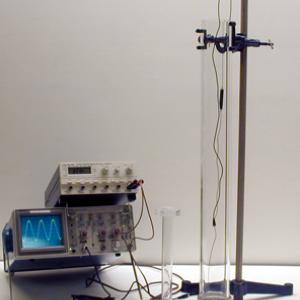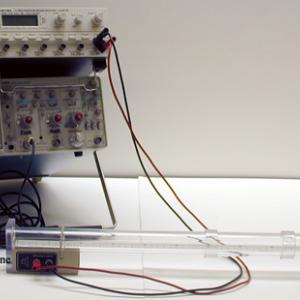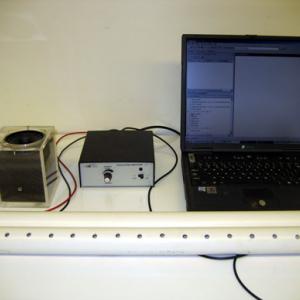College of Liberal Arts & Sciences
3D30.15 - Standing Waves in a Tube
Place the tube in an upright position with the meter stick along side as shown to measure the distances between the microphone and the speaker. Plug the microphone into the preamp and output the preamp to the oscilloscope input along with a frequency counter. Be sure you have a good battery in the microphone. Plug the wave generator into the amplifier and the other output of the generator into the frequency counter. Plug the speaker attached to the tube into the amplifier speaker outputs. Information on the parameters of the tube and the frequencies and observed nodes will be found in the file.
Several things can be explored with the PVC pipe that has the holes in it. Put a speaker at one end and a microphone at the other. Using "Matlab" on the computer you can generate a ramping frequency and look at the spectrum received. Plugging one or several holes will markedly change the spectrum.
- Chris Chiaverina, "Totally Tubular", TPT, Vol. 60, #7, Oct. 2022, p. 620.
- Karel Kok, Franz Boczianowski, "Acoustic Standing Waves: A Battle Between Models", TPT, Vol. 59, #3, March 2021, p. 180.
- Rosly Jaafar, Shahrul Kadri Ayop, Ahmad Tarmimi Ismail@Illias, Kok Keng Hon, Anis Nazihah Mat Daud, and Mohd Helmy Hashim, "Visualization of Harmonic Series in Resonance Tubes Using a Smartphone", TPT, Vol. 54, #9, Dec. 2016, p. 545.
- Andreas Müller, Michael Hirth, and Jochen Kuhn, "Tunnel Pressure Waves – A Smartphone Inquiry on Rail Travel", TPT, Vol. 54, #2, Feb. 2016, p. 118.
- Yaakov Kraftmakher, "Standing Sound Waves in Air with DataStudio", TPT, Vol. 48, #2, Feb. 2010, p. 122.
- David Potter, "Phase Changes in Reflected Sound Waves", TPT, Vol. 41, #1, Jan. 2003, p. 12.
- Jay S. Huebner and N. Sundaralingam, "Simple Sound Demonstrations", TPT, Vol. 36, #1, Jan. 1998, p. 16.
- M. G. Raymer and Stan Micklavzina, "Demonstrating Sound Impulses in Pipes", TPT, Vol. 33, #3, Mar. 1995, p. 183.
- Vincent Santarelli, Joyce Carolla, and Michael Ferner, "Standing Waves in a Mailing Tube", TPT, Vol. 31, #9, Dec. 1993, p. 557.
- Donald E. Shult, "Tone Holes and Frequency of Open Pipes", TPT, Vol. 29, #1, Jan. 1991, p. 16.
- Joe Pizzo, "Echo Tube", TPT, Vol. 24, #7, Oct. 1986, p. 428.
- Brian W. Holmes and Mario L. Capitolo, "Acoustics Demonstration Tube", TPT, Vol. 24, #5, May 1986, p. 297.
- R. D. Edge, "Vibration in Pipes", TPT, Vol. 18, #5, May 1980, p. 383.
- Raoul J. Fajardo, "Acoustic Resonance Demonstration Apparatus", TPT, Vol. 16, #5, May 1978, p. 313.
- Seymour Trester, "Erratum: 'Pressure Variation Along a Longitudinal Standing Wave in a Gas'", TPT, Vol. 16, #1, Jan. 1978, p. 8.
- Seymour Trester, "Pressure Variation Along a Longitudinal Standing Wave in a Gas", TPT, Vol. 15, #7, Oct. 1977, p. 426.
- Edgar Pearlstein, "More on Resonating Golf Tubes", TPT, Vol. 13, #7, Oct. 1975, p. 438.
- J. J. Veit, "Resonating Golf Tube", TPT, Vol. 13, #5, May 1975, p. 308.
- J. M. Reynolds, "Sound in a Tube", TPT, Vol. 11, #5, May 1973, p. 311.
- Alexander L. Feldman, "Resonant Energy Transfer and Coupling Apparatus for Training in Scientific Reasoning", TPT, Vol. 9, #4, Apr. 1971, p. 198.
- Jerry L. Underfer, "Misconceptions About Resonance in Vibrating Air Columns", TPT, Vol. 4, #2, Feb. 1966, p. 81.
- Daniel A. Russell, David E. Parker, and Russell S. Hughes, "Analysis of Standing Sound Waves Using Holographic Interferometry", AJP, Vol. 77, #8, Aug. 2009, p. 678.
- Willy Haeberli, "Laboratory Exercises on Oscillation Modes of Pipes", AJP, Vol. 77, #3, Mar. 2009, p. 204.
- Thomas D. Rossing, "Experiments with an Impedance Tube in the Acoustics Laboratory", AJP, Vol. 50, #12, Dec. 1982, p. 1137.
- Martin C. Sagendorf, "Sound Tubes", Physics Demonstration Apparatus, 2009, p. 50.
- George M. Hopkins, "Re-Enforcement of Sound", Experimental Science, p. 141.
- Otto Lührs, "Gases Reveal Standing Waves in Tubes", Physics Education, Vol. 39, #4, July 2004, p. 333.
- "Standing Waves: Resonance in a Tube", Lab Experiment, Johns Hopkins University, 2005.
- Paul Doherty, "Vertical Slinky", The Exploratorium Summer Institute, May 2000.
- "1.44: End Effects on Open-Ended Pipes", The Flying Circus of Physics with Answers.
- "7.03: Waves in Pipes", String and Sticky Tape Experiments.
- "Another Resonance Tube Demonstration", PIRA Newsletter, Vol. 8, #3, Dec. 1993, p. 32.
- W. Bolton, "Resonance in Air Columns", Book I - Properties of Materials, Physics Experiments and Projects, 1968, p. 50 - 51.
Disclaimer: These demonstrations are provided only for illustrative use by persons affiliated with The University of Iowa and only under the direction of a trained instructor or physicist. The University of Iowa is not responsible for demonstrations performed by those using their own equipment or who choose to use this reference material for their own purpose. The demonstrations included here are within the public domain and can be found in materials contained in libraries, bookstores, and through electronic sources. Performing all or any portion of any of these demonstrations, with or without revisions not depicted here entails inherent risks. These risks include, without limitation, bodily injury (and possibly death), including risks to health that may be temporary or permanent and that may exacerbate a pre-existing medical condition; and property loss or damage. Anyone performing any part of these demonstrations, even with revisions, knowingly and voluntarily assumes all risks associated with them.



